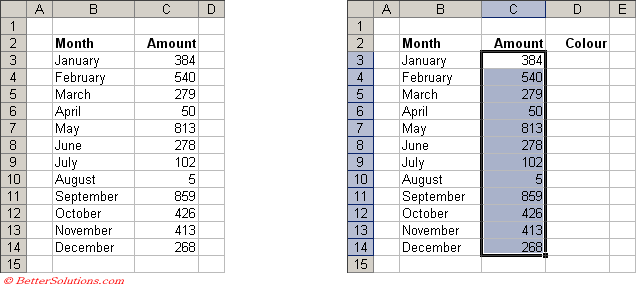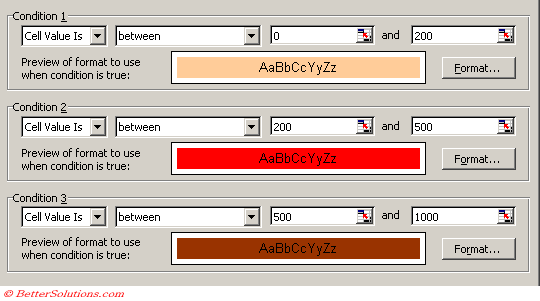Sorting
You cannot currently sort a cell range based on the conditional formatting, however an alternative is to insert the same condition in the corresponding row or column, so it returns True or False. You can then sort by this row or column.
SS
You can use conditional formatting as a way to check that the data is sorted correctly.
Have 2 conditions A2<A1 and A2 > A1
Using Manual Formatting
If you want to sort using the background colour of the cells you can refer to the Interior property of the Range object
Range("C3").Interior.ColorIndex
If you want to sort using the colour of the text you can use the Font property of the Range object.
Range("C3").Font.ColorIndex
For more details please refer to the Sorting by Colour page.
Additional Column
Lets assume that you have a simple table of data and that the formatting has been applied using Conditional Formatting.
You must first add another column to your table of data.
This extra column will contain a user defined function which can be used to indicate the order in which to sort the rows.
 |
Enter Conditions
Select the cells you want to apply the conditional formatting to, in this case "C3:C14".
Press (Format > Conditional Formatting) to display the Conditional Formatting dialog box.
Enter the three conditions, we have used constants to keep it simple.
 |
Conditional Formatting
If a cell has been formatted with Conditional Formatting then using the ColorIndex of the cell will not work.
The following two properties are undefined when you have applied conditional formatting.
Range("C3").Interior.ColorIndex
Range("C3").Font.ColorIndex
The only way to determine the type of formatting applied is to analyse the Conditional Formatting directly.
Dim objFormatConditions As FormatConditions
objFormatConditions(1).Interior.ColorIndex
objFormatConditions(1).Font.ColorIndex
User Defined Function
This user defined function will return the colour index of the cell reference which is passed as the first argument.
The number returned will always be between 1 and 52 since this corresponds to the location on the colour palette.
Once the user defined function has been entered into a code module in the corresponding VBA Project you can use it in your extra column.
If the cell does not contain any conditional formatting then 0 is returned.
Option Explicit
Public Function ColourSorting(ByVal rgeCell As Range, _
ByVal bBackGround As Boolean, _
ByVal bText As Boolean) As Integer
Dim iconditionno As Integer
If rgeCell.FormatConditions.Count = 0 Then Exit Function
iconditionno = ConditionNo(rgeCell)
If bBackGround = True Then
ColourSorting = rgeCell.FormatConditions(iconditionno).Interior.ColorIndex
End If
If bText = True Then
ColourSorting = rgeCell.FormatConditions(iconditionno).Font.ColorIndex
End If
End Function
Private Function ConditionNo(ByVal rgeCell As Range) As Integer
Dim iconditionscount As Integer
Dim objFormatCondition As FormatCondition
For iconditionscount = 1 To rgeCell.FormatConditions.Count
Set objFormatCondition = rgeCell.FormatConditions(iconditionscount)
Select Case objFormatCondition.Type
Case xlCellValue
Select Case objFormatCondition.Operator
Case xlBetween: If Compare(rgeCell.Value, ">=", objFormatCondition.Formula1) = True And _
Compare(rgeCell.Value, "<=", objFormatCondition.Formula2) = True Then _
ConditionNo = iconditionscount
Case xlNotBetween: If Compare(rgeCell.Value, "<=", objFormatCondition.Formula1) = True And _
Compare(rgeCell.Value, ">=", objFormatCondition.Formula2) = True Then _
ConditionNo = iconditionscount
Case xlGreater: If Compare(rgeCell.Value, ">", objFormatCondition.Formula1) = True Then _
ConditionNo = iconditionscount
Case xlEqual: If Compare(rgeCell.Value, "=", objFormatCondition.Formula1) = True Then _
ConditionNo = iconditionscount
Case xlGreaterEqual: If Compare(rgeCell.Value, ">=", objFormatCondition.Formula1) = True Then _
ConditionNo = iconditionscount
Case xlLess: If Compare(rgeCell.Value, "<", objFormatCondition.Formula1) = True Then _
ConditionNo = iconditionscount
Case xlLessEqual: If Compare(rgeCell.Value, "<=", objFormatCondition.Formula1) = True Then _
ConditionNo = iconditionscount
Case xlNotEqual: If Compare(rgeCell.Value, "<>", objFormatCondition.Formula1) = True Then _
ConditionNo = iconditionscount
If ConditionNo > 0 Then Exit Function
End Select
Case xlExpression
If Application.Evaluate(objFormatCondition.Formula1) Then
ConditionNo = iconditionscount
Exit Function
End If
End Select
Next iconditionscount
End Function
Private Function Compare(ByVal vValue1 As Variant, _
ByVal sOperator As String, _
ByVal vValue2 As Variant) As Boolean
If Left(CStr(vValue1), 1) = "=" Then vValue1 = Range(Mid(CStr(vValue1), 2)).Value
If Left(CStr(vValue2), 1) = "=" Then vValue2 = Range(Mid(CStr(vValue2), 2)).Value
If IsNumeric(vValue1) = True Then vValue1 = CDbl(vValue1)
If IsNumeric(vValue2) = True Then vValue2 = CDbl(vValue2)
Select Case sOperator
Case "=": Compare = (vValue1 = vValue2)
Case "<": Compare = (vValue1 < vValue2)
Case "<=": Compare = (vValue1 <= vValue2)
Case ">": Compare = (vValue1 > vValue2)
Case ">=": Compare = (vValue1 >= vValue2)
Case "<>": Compare = (vValue1 <> vValue2)
End Select
End Function
© 2025 Better Solutions Limited. All Rights Reserved. © 2025 Better Solutions Limited TopPrevNext